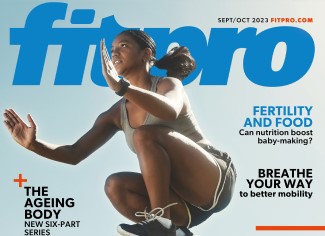Magazine References
Sep – Oct 2023

Pg 6 Ageing and skeletal changes
References
- Inger D et al (2014), Tensegrity, cellular biophysics and the mechanics of living systems, Rep Prog Phys., 77(4).
- Feskanich D, Willett W, Colditz G (2002), Walking and leisure-time activity and risk of hip fracture in postmenopausal women, JAMA, 288(18): 2,300-06.
- Pinheiro M et al (2020), Evidence on physical activity and osteoporosis prevention for people 65+: A systematic review of the WHO guidelines on physical activity and sedentary behaviour, International Journal of Behavioural Nutrition and Physical Activity, 17(150).
- Santos L et al (2017), Exercise and bone health across the lifespan, Biogerontology, 18(6): 931-946.
- Benedetti MG et al (2018), The effectiveness of physical exercise on bone density in osteoporotic patients, Biomed Res Int., 4840531.
- Tucker LA, Strong JE, Lecheminant JD et al (2014), Effect of two jumping programs on hip bone mineral density in premenopausal women: A randomized controlled trial, American Journal of Health Promotion, 24.
Pg 8 Nutrition and fertility
References
- British Dietetic Association: Diet and Fertility Update, https://www.bda.uk.com/resource/a-clinical-update-on-diet-and-fertility.html accessed on 31 August 2023.
- Statistica: Total fertility rate in the United Kingdom from 1961 to 2021 https://www.statista.com/statistics/284042/fertility-rate-in-the-united-kingdom-uk/ accessed on 31 August 2023.
- Gaskin et al (2018), Diet and fertility: A review, Am J Obstet Gynecol., 218(4): 379-389.
- Skoracka K et al (2018), The influence of female fertility and the nutritional approach: Most essential aspects, Fron Public Health, 6: 211.
- Xiashuai Z et al (2008), The effect of low carbohydrate diet on Polycystic Ovary Syndrome: A meta-analysis of randomised controlled trials, Am J Obstet Gynecol., 198(2): 210.
- Muffone R et al, Mediterranean diet and infertility: a systematic review with meta-analysis of cohort studies, Nutrition Reviews, 81: 775-789.
- Salas-Huetos (2019), Diet and sperm quality: Nutrients, foods and dietary patterns, Reprod Biol., 19(3): 219-224.
- Jorge C et al (2018), Protein intake and infertility, Dialogues Clin Neurosci., 20(1): 41-47.
- Fan-Long et al (2020), Relationship between caffeine intake and infertility: a systematic review of controlled clinical studies, MC Women’s Health, 20: 125.
- Van Heertum K et al (2017), Alcohol and fertility: How much is too much? Fertil Red Pract., 3: 10.
- Rooney K et al (2019), The relationship between stress and infertility. In Mikkelsen E et al (2016), Alcohol consumption and fecundability: A prospective Danish cohort study, BMJ, 354: 4,262.
- Vitagliano A et al (2021), Dietary supplements for female infertility: A critical review of their composition, Nutrients, 13(10): 3,552.
- Garolla A (2021), Systemativ review and critical analysis on dietary supplements for Male infertility: From a blend of ingredients to a rational strategy, Front Endocrinol., 12-2021.
Pg 32 Effective training prescription for change of direction performance
References
- David S, Mundt M, Komnik I, Potthast W (2018), Understanding cutting maneuvers – The mechanical consequence of preparatory strategies and foot strike pattern, Human Movement Science, 62: 202-10.
- Wyatt H, Weir G, van Emmerik R, Jewell C, Hamill J (2019), Whole-body control of anticipated and unanticipated sidestep manoeuvres in female and male team sport athletes, Journal of Sports Sciences, 37(19): 2,263-9.
- Young WB, Dawson B, Henry GJ (2015), Agility and change-of-direction speed are independent skills: Implications for training for agility in invasion sports, International Journal of Sports Science & Coaching, 10(1): 159-69.
- Serpell BG, Young WB, Ford M (2011), Are the perceptual and decision-making components of agility trainable? A preliminary investigation, The Journal of Strength & Conditioning Research, 25(5): 1,240-8.
- Alanen AM, Räisänen AM, Benson LC, Pasanen K (2021), The use of inertial measurement units for analyzing change of direction movement in sports: A scoping review, International Journal of Sports Science & Coaching, 16(6): 1,332-53.
- Loturco I, Pereira LA, Reis VP, Abad CC, Freitas TT, Azevedo PH, Nimphius S (2022), Change of direction performance in elite players from different team sports, Journal of Strength and Conditioning Research, 36(3): 862-6.
- Dos’ Santos T, Thomas C, Jones PA, Comfort P (2019), Assessing asymmetries in change of direction speed performance: Application of change of direction deficit, The Journal of Strength & Conditioning Research, 33(11): 2,953-61.
- McBurnie AJ, Dos’ Santos T (2022), Multidirectional speed in youth soccer players: theoretical underpinnings, Strength and Conditioning Journal, 44(1): 15-33.
- Talty PF, McGuigan K, Quinn M, Jones PA (2022), Agility demands of Gaelic football match-play: a time-motion analysis, International Journal of Performance Analysis in Sport, 22(2): 195-208.
- Emmonds S, Nicholson G, Begg C, Jones B, Bissas A (2019), Importance of physical qualities for speed and change of direction ability in elite female soccer players, The Journal of Strength & Conditioning Research, 33(6): 1,669-77.
- Dos’ Santos T, Thomas C, McBurnie A, Comfort P, Jones PA (2021), Change of direction speed and technique modification training improves 180 turning performance, kinetics, and kinematics, Sports, 9(6): 73.
- Freitas TT, Pereira LA, Alcaraz PE, Azevedo PH, Zanetti V, Pantarotto NB, Reis VP, Jeffreys I, Loturco I (2023), Mixed training programs applied to young soccer players: Effects on speed-power abilities, International Journal of Sports Medicine, 6.
- Brughelli M, Cronin J, Levin G, Chaouachi A (2008), Understanding change of direction ability in sport: A review of resistance training studies, Sports Medicine, 38: 1,045-63.
- Harper DJ, McBurnie AJ, Santos TD, Eriksrud O, Evans M, Cohen DD, Rhodes D, Carling C, Kiely J (2022), Biomechanical and neuromuscular performance requirements of horizontal deceleration: A review with implications for random intermittent multi-directional sports, Sports Medicine, 52(10): 2,321-54.
- McBurnie AJ, Harper DJ, Jones PA, Dos’ Santos T (2022), Deceleration training in team sports: Another potential ‘vaccine’ for sports-related injury? Sports Medicine, 1-2.
- Bishop C, Brashill C, Abbott W, Read P, Lake J, Turner A (2021), Jumping asymmetries are associated with speed, change of direction speed, and jump performance in elite academy soccer players, The Journal of Strength & Conditioning Research, 35(7): 1,841-7.
- Granero-Gil P, Bastida-Castillo A, Rojas-Valverde D, Gómez-Carmona CD, de la Cruz Sánchez E and Pino-Ortega J (2020), Influence of contextual variables in the changes of direction and centripetal force generated during an elite-level soccer team season, International Journal of Environmental Research and Public Health, 17(3): 967.
- Dos’ Santos T, Thomas C, Comfort P and Jones PA (2018), The effect of angle and velocity on change of direction biomechanics: An angle-velocity trade-off, Sports Medicine, 48: 2,235-53.
- Jones PA, Herrington L and Graham-Smith P (2016), Braking characteristics during cutting and pivoting in female soccer players, Journal of Electromyography and Kinesiology, 30: 46-54.
- Nimphius S, Callaghan SJ, Spiteri T and Lockie RG (2016), Change of direction deficit: A more isolated measure of change of direction performance than total 505 time, Journal of Strength and Conditioning Research, 30(11): 3,024-32.


